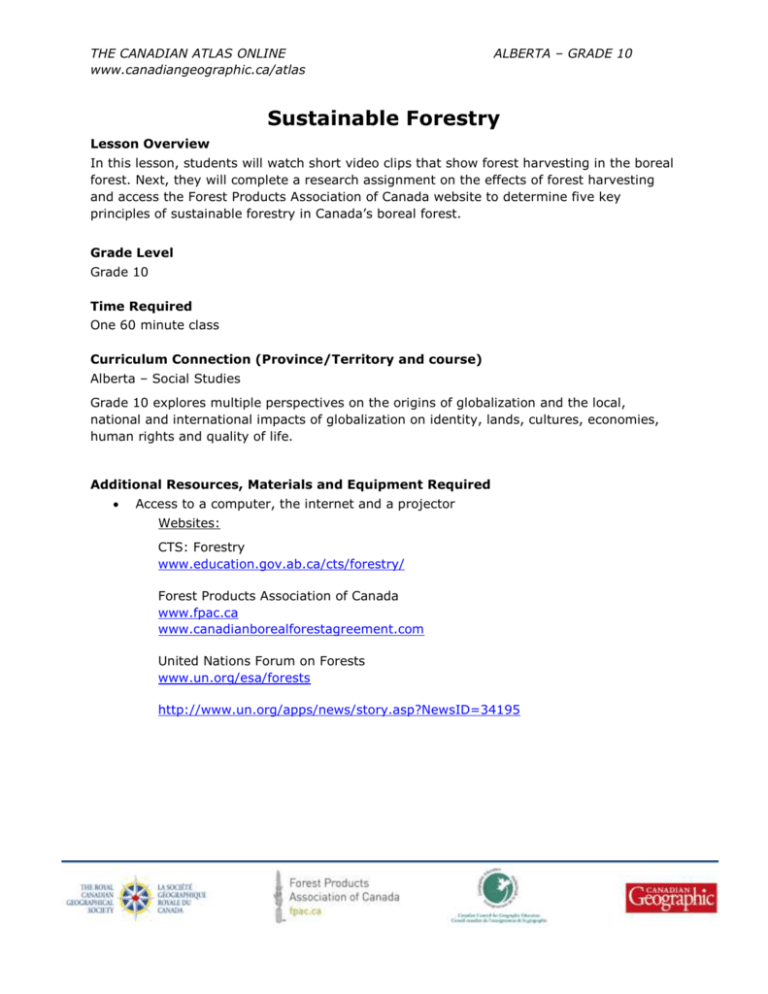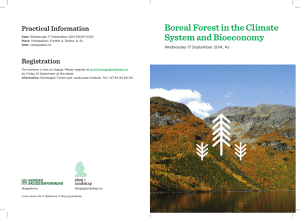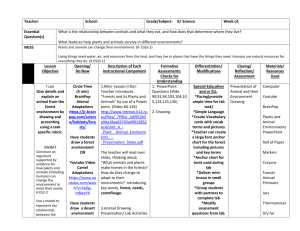The Lesson - Canadian Geographic
advertisement

THE CANADIAN ATLAS ONLINE www.canadiangeographic.ca/atlas ALBERTA – GRADE 10 Sustainable Forestry Lesson Overview In this lesson, students will watch short video clips that show forest harvesting in the boreal forest. Next, they will complete a research assignment on the effects of forest harvesting and access the Forest Products Association of Canada website to determine five key principles of sustainable forestry in Canada’s boreal forest. Grade Level Grade 10 Time Required One 60 minute class Curriculum Connection (Province/Territory and course) Alberta – Social Studies Grade 10 explores multiple perspectives on the origins of globalization and the local, national and international impacts of globalization on identity, lands, cultures, economies, human rights and quality of life. Additional Resources, Materials and Equipment Required Access to a computer, the internet and a projector Websites: CTS: Forestry www.education.gov.ab.ca/cts/forestry/ Forest Products Association of Canada www.fpac.ca www.canadianborealforestagreement.com United Nations Forum on Forests www.un.org/esa/forests http://www.un.org/apps/news/story.asp?NewsID=34195 THE CANADIAN ATLAS ONLINE www.canadiangeographic.ca/atlas ALBERTA – GRADE 10 Access to internet video clips: Greenpeace Canada - Taking Action for the Boreal Forest; A Look Back http://www.youtube.com/watch?v=qtcwFVeYna4 Canadian Boreal Initiative, Suzuki Foundation, Boreal Songbird Initiative Conservation Value of the North American Boreal Forest from an Ethnobotanical Perspective (three short video clips at the bottom of the page) http://www.borealbirds.org/ethnobotany.shtml#video Appendix A: Student Worksheet (attached) Appendix B: Answer Key (attached) Main Objective Student will understand the causes and effects of global deforestation and explore the idea of sustainable forestry in Canada. Learning Outcomes By the end of the lesson, students will be able to: Define and explain the terms deforestation and conversion; Distinguish between a primary forest, secondary forest, disturbed forest, frontier forest and forest plantation; Communicate the value of forests to humans; Argue for changes in global forest management; Propose what can be done to preserve, manage and restore forests; Indicate the five key principles of forest sustainability. The Lesson Introduction The Lesson Teacher Activity Ask the class if they are familiar with the term deforestation. Based on its etymology, have the students create a definition. Student Activity Respond to the question. Show the Greenpeace Canada video clip. Watch the video. Record students’ reactions to video. React to the video. THE CANADIAN ATLAS ONLINE www.canadiangeographic.ca/atlas Lesson Development ALBERTA – GRADE 10 Indicate to the class that they will be doing research on the topic of global deforestation. Draw their attention to the following websites: CTS Forestrywww.education.gov.ab.ca/cts/forestry/ Conclusion Forest Products Association of Canada website www.fpac.ca for in-depth information about the boreal forest in Canada and the Canadian Boreal Forest Agreement United Nations Forum on Forests website www.un.org/esa/forests for information about International Year of Forests 2011. Distribute Appendix A: Student Worksheet. Provide one worksheet for each student. Review the instructions with the class. Assist students with research as required. Ask students to submit the completed worksheets. Show the second forest harvesting video. Record students’ reactions to the second video. Ask concluding questions: What is global deforestation? How does it affect all people? Did your knowledge of deforestation change: -after the first video? -after the research? -after the second video? If so, how? Listen and ask questions as they arise. Conduct research. Complete worksheet as instructed. Submit completed worksheet. Watch the second deforestation video. React to the video. Respond to the questions. THE CANADIAN ATLAS ONLINE www.canadiangeographic.ca/atlas ALBERTA – GRADE 10 Lesson Extension Organize a field trip to the Devonian Botanic Garden at the University of Alberta. www.ales.ualberta.ca/devonian/EducationCourses Visit the Government of Alberta Sustainable Resource Development website at http://srd.alberta.ca/ and create a class collage of imaginary newspaper headlines detailing the latest news in forest management in Alberta. Visit the Canadian Forestry Association website at www.canadianforestry.com Assessment of Student Learning Students can be assessed based on their participation, classroom discussions and their successful completion of the Student Worksheet. Further Reading Canadian Geographic/FPAC Boreal Forest poster-map Canadian Atlas Online Future of Forestry theme www.canadiangeographic.ca/atlas Canadian Geographic/FPAC Boreal Forest interactive map www.canadiangeographic.ca/boreal Link to Canadian National Standards for Geography Essential Element #2: Places and Regions Physical and human processes shape places and regions Changes in places and regions over time Interdependence of places and regions Critical issues and problems of places and regions Regional analysis of geographic issues and questions Essential Element #5: Environment and Society Global effects of human modification of the physical environment Global effects on the human environment by changes in the physical environment World patterns of resource distribution and utilization Use and sustainability of resources Environmental issues (e.g. global warming, loss of biodiversity, deforestation, ozone depletion, air pollution, water pollution, acid precipitation, disposal of solid waste) Geographic Skill #1: Asking Geographic Information Plan and organize a geographic research project. (e.g. Specify a problem, pose a research question or hypothesis and identify data sources) Geographic Skill #2: Acquiring Geographic Information Systematically locate and gather geographic information from a variety of primary and secondary sources. Geographic Skill #5: Answering Geographic Questions Evaluate the answers to geographic questions. THE CANADIAN ATLAS ONLINE www.canadiangeographic.ca/atlas ALBERTA – GRADE 10 Appendix A: Student Worksheet Please answer the following questions to the best of your ability and in complete sentences. 1. What is global deforestation/conversion? 2. Distinguish between a primary forest, secondary forest, disturbed forest, frontier forest and forest plantation. 3. Why are forests important for human use and consumption? Provide examples. 4. Why do we need major changes in global forest management? THE CANADIAN ATLAS ONLINE www.canadiangeographic.ca/atlas ALBERTA – GRADE 10 5. What can be done to preserve, manage and restore forests? 6. According to the Forest Products Association of Canada: Increasingly, when buying wood or paper products, consumers are seeking assurances that the products derive from producers that are sustainable and environmentally responsible. But just how do consumers identify a responsible supplier of sustainable forest products? Visit: http://www.fpac.ca/index.php/en/our-committments/ and answer this question: Consumers should look for wood and paper that come from responsible sources that respect five key principles of sustainability. List and describe each principle. THE CANADIAN ATLAS ONLINE www.canadiangeographic.ca/atlas ALBERTA – GRADE 10 Appendix B: Answer Key 1. Global deforestation/conversion: The conversion of forest to another land use or the long-term reduction of the tree canopy cover below a 10 percent threshold. Deforestation is the long-term or permanent loss of forest cover and its transformation into another land use. 2. Primary forest: is a forest that has never been logged and has developed following natural disturbances and under natural processes, regardless of its age. Secondary forests: are forests regenerating largely through natural processes after significant human or natural disturbance, and which differ from primary forests in forest composition and/or canopy structure. Disturbed forests: any forest type that has in its interior significant areas of disturbance by people, including clearing, felling for wood extraction, anthropogenic fires, road construction, insects, disease, etc. Frontier forests: large, ecologically intact, and relatively undisturbed forests that support the natural range of species and forest functions (WRI definition). Forest plantation is one established by planting or/and seeding in the process of reforestation. It consists of introduced species or, in some cases, indigenous species. 3. Importance of Forests: Forest products: wood to burn for cooking, lumber, plywood for building homes, pulp for paper and boxes, dyes for clothing, nuts and berries for food, maple syrup, medicines and mushrooms. Forests influence our climate: fluctuations in carbon dioxide levels which can affect us globally 4. Need for forest management: Some of the world’s plant and animal species are becoming critically rare (loss of biodiversity). 5. What can be done? Involve indigenous people in forest management; adopt better laws and law enforcement tools; teach others about the importance of the environment and how they can help save rainforests; restore damaged ecosystems by planting trees on land where forests have been cut down; encourage people to live in a way that doesn't hurt the environment; establish parks to protect rainforests and wildlife; support companies that operate in ways that minimize damage to the environment. 6. Five Principles: Harvest legally, prompt regeneration, no waste, welcome independent scrutiny, reduce greenhouse gases. (Descriptions of the principles will vary.)








